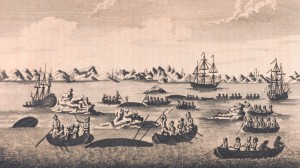3:5.
Question # 4
One of the instances of King’s “narrative decolonization” that I found particularly interesting was the sequence in which Changing Woman encounters Ahab, the protagonist from Moby Dick. The passage ambles in King’s non-linear fashion; he weaves references from Herman Melville’s Moby Dick into the Coyote narrative, to produce a dream-like sequence in which Western literary texts are split open, stretched apart and disassembled. The narrative follows Changing woman, who (as is outlined in the introductory material to this lesson) is a figure which will be unfamiliar to a non-First Nations audience. The passage thus constitutes an encounter: a re-imagining/re-assembling of Western and First Nations stories and cultural frameworks. By imbedding Changing Woman within a comic perversion of Moby Dick (one of the hallmarks of the Western literary canon) King disorients the ideological scripts that police the precincts of Western cultural and artistic achievement. The violence of the whale hunt seems to symbolically encode the violence of western imperialism, as well as the violence of white male privilege. King writes:
“And everyone grabs their spears and knives and juicers and chain saws and blenders and axes and they leap into little wooden boats and chase whales. And. When they catch the whales. They kill them” (195).
King draws a linkage between the European imperial project (whale hunting as one expression of this project) and the institutionalized racism and sexism that permeated the canonization of certain works of Western literature. The exchange between Ahab and Changing Woman clearly illustrates this: “We’re looking for the white whale, Ahab tells his men. Keep looking. (…) Black whale? yells Ahab. You mean white whale, don’t you? Moby-Dick, the great male white whale? That’s not a white whale, says Changing Woman. That’s a female whale and she’s black (196).”
It is difficult not to miss the highly charged racial and sexual politics **(click on link for a discussion of the intersection between settler colonialism and patriarchy) of this exchange. Positing Changing Woman as the spokesperson for silenced discourses (those belonging to women and non-Europeans) King injects the story of the oppressor with the voices of the oppressed.
Another instance of narrative decolonization is the sequence in the realist story, in which the narrative line cuts between scenes of characters all watching the same Western (pages 214-221). The Western, featuring John Wayne, replete with its images of charging cavalry and ‘Indians’ on horseback, serves as a frame through which King filters the experiences of his characters. The clichéd archetypes presented in the pop culture genre of the Western, seem hollow and sterile in comparison to the vibrantly complex and psychologically nuanced characters that King has created. This tension between the Hollywood version of “Indian-ness” and the lived realities of First Nations people is central to King’s commentary and to his textual decolonization. I referred in my discussion of Moby-Dick to the violence of white male privilege. In this particular passage, we find a different kind of violence: the violence of having one’s identity subsumed into hollow stereotypes, and commodified as a product in the entertainment business.
Works Cited
King, Thomas. Green Grass Running Water. Toronto: Harper Collins, 1993. Print.


Hi Laura,
I enjoyed reading your examples of King’s narrative decolonization. In the novel I found it particularly interesting to see how the Western movie played out in Bill Bursum’s store. During this section we see a literal reversal of the stereotypes that you discussed. The presence of the four Indians in the store caused the Indians in the movie to become victorious; “The Indians charged out of the river and massacred John Wayne and Richard Widmark” (King 367). Bursum is unhappy with the film’s ending, and keeps trying to rewind the tape. It is evident that the film’s reversal of stereotypes illustrates resistance and a forced acknowledgment of power relations that dictated these stereotypes both historically and in modern times. Which evidently is something that Bursum does not want to confront just yet; ““well something sure as hell got screwed up” ( King 259).
-Sarah